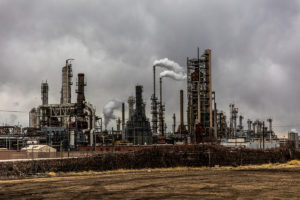Industrial risk management in France is well taken into account. It has progressed with the European Seveso directive directive of 1976 and its subsequent versions, up to the Risks Law law of 2003. However, zero risk does not exist. "The industrial risk is defined as an accidental event occurring on an industrial site involving dangerous products and/or processes and leading to immediate serious consequences for personnel, local residents, property and the environment" (Source: inrs.fr). A pollution during an industrial accident cannot be excluded. The Post-Rouen regulations, to the elaboration of which Gesip contributed its expertise, have made it possible to significantly reinforce the obligations of Seveso sites as well as the prescriptions relative to the prevention of fire risks and the limitation of their consequences, in the storage of flammable and combustible liquids as well as in warehouses.
Pollution risks during an industrial crisis event
Industrial risks, related to nuclear energy or to the management of dangerous products, are called technological risks. These are risks generated by human activity, risks of an industrial nature. They affect the environment in its broadest sense (air pollution, work environment, soil pollution, etc.).
When an industrial accident occurs, it is classified according to its effects:
- Toxic risks (the pollution and dispersion of toxic substances, in the air, water or soil, of dangerous products with toxicity for humans by inhalation, ingestion or contact) : air pollution, work environment, soil pollution... ;
- Thermal risks (explosion or fire) ;
- Risk of overpressure (when an explosion causes structures to collapse).
All industrial accidents that have occurred in ICPE (installations classified for environmental protection) are recorded. They are listed in the ARIA database, including for facilities classified as Seveso.
Examples of pollution during industrial accidents
The European Seveso directive and the PPRTs (plans for the prevention of technological risks) set up in France have a dual objective. Their aim is to reduce the risks and limit the consequences in the event of an industrial crisis.
The major risk sites are thus divided into two categories, "SEVESO High Threshold" and "SEVESO Low Threshold. And this, according to the level of the dangerous substances present on the sites.
The PPRT were set up via the Bachelot law of 30/07/2003 around the SEVESO High Threshold establishments.
Fire at the Rouen plant
Following the fire at the Seveso classified facilities, an action plan for the prevention and management of industrial risks has been put in place. It provides for the following measures:
- An improvement in the prevention of industrial risks;
- Anticipations of accident management;
- Better long-term monitoring of health and environmental consequences;
- Reinforcement of preventive controls.
As part of its deployment, 3 billion euros will be invested by manufacturers to modernize their warehouses and 450 million euros for the chemical industry.
Seven pieces of legislation have been issued. Among them, two major decrees:
- Decree 2020-1168: this concerns the rules applicable to facilities where hazardous substances may be the cause of major accidents. For example, the provision of information to the public on major accidents, such as what to do in the event of an alert, or the reinforcement of information to the prefect;
- Decree 2020-1169: it modifies the nomenclature of ICPE (installations (classified installations for the protection of the environment).
Gesip's action to improve the safety of establishments in the event of an industrial accident
Gesip is committed to working with industrial players and the administration to change legislation in order to reduce the risk of large-scale fires (fire and smoke propagation) and limit their impact. Gesip has thus led a working group bringing together the entire profession to participate in the establishment of the post-Rouen governmental plan.
More generally, Gesip's action to improve the industrial safety of people and equipment focuses on
- training of industrialists, on Gesip's technical platforms, in safety on industrial sites;
- the drafting of methodological guides for the operator;
- the implementation of information for all industrial operators concerning the evolution of the legislation in place.

